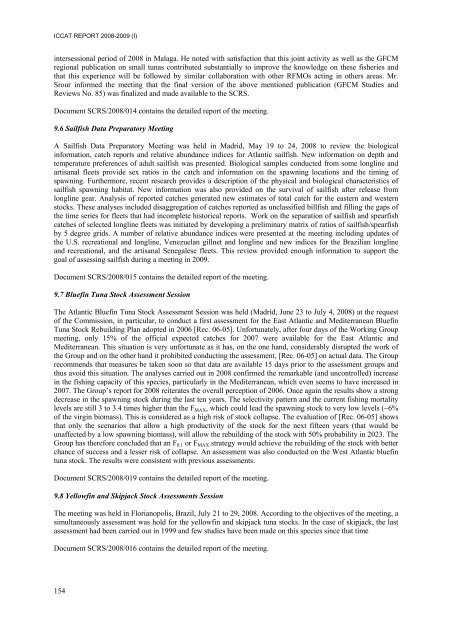REPORT OF THE STANDING COMMITTEE ON RESEARCH ... - Iccat
REPORT OF THE STANDING COMMITTEE ON RESEARCH ... - Iccat
REPORT OF THE STANDING COMMITTEE ON RESEARCH ... - Iccat
Create successful ePaper yourself
Turn your PDF publications into a flip-book with our unique Google optimized e-Paper software.
ICCAT <strong>REPORT</strong> 2008-2009 (I)intersessional period of 2008 in Malaga. He noted with satisfaction that this joint activity as well as the GFCMregional publication on small tunas contributed substantially to improve the knowledge on these fisheries andthat this experience will be followed by similar collaboration with other RFMOs acting in others areas. Mr.Srour informed the meeting that the final version of the above mentioned publication (GFCM Studies andReviews No. 85) was finalized and made available to the SCRS.Document SCRS/2008/014 contains the detailed report of the meeting.9.6 Sailfish Data Preparatory MeetingA Sailfish Data Preparatory Meeting was held in Madrid, May 19 to 24, 2008 to review the biologicalinformation, catch reports and relative abundance indices for Atlantic sailfish. New information on depth andtemperature preferences of adult sailfish was presented. Biological samples conducted from some longline andartisanal fleets provide sex ratios in the catch and information on the spawning locations and the timing ofspawning. Furthermore, recent research provides a description of the physical and biological characteristics ofsailfish spawning habitat. New information was also provided on the survival of sailfish after release fromlongline gear. Analysis of reported catches generated new estimates of total catch for the eastern and westernstocks. These analyses included disaggregation of catches reported as unclassified billfish and filling the gaps ofthe time series for fleets that had incomplete historical reports. Work on the separation of sailfish and spearfishcatches of selected longline fleets was initiated by developing a preliminary matrix of ratios of sailfish/spearfishby 5 degree grids. A number of relative abundance indices were presented at the meeting including updates ofthe U.S. recreational and longline, Venezuelan gillnet and longline and new indices for the Brazilian longlineand recreational, and the artisanal Senegalese fleets. This review provided enough information to support thegoal of assessing sailfish during a meeting in 2009.Document SCRS/2008/015 contains the detailed report of the meeting.9.7 Bluefin Tuna Stock Assessment SessionThe Atlantic Bluefin Tuna Stock Assessment Session was held (Madrid, June 23 to July 4, 2008) at the requestof the Commission, in particular, to conduct a first assessment for the East Atlantic and Mediterranean BluefinTuna Stock Rebuilding Plan adopted in 2006 [Rec. 06-05]. Unfortunately, after four days of the Working Groupmeeting, only 15% of the official expected catches for 2007 were available for the East Atlantic andMediterranean. This situation is very unfortunate as it has, on the one hand, considerably disrupted the work ofthe Group and on the other hand it prohibited conducting the assessment, [Rec. 06-05] on actual data. The Grouprecommends that measures be taken soon so that data are available 15 days prior to the assessment groups andthus avoid this situation. The analyses carried out in 2008 confirmed the remarkable (and uncontrolled) increasein the fishing capacity of this species, particularly in the Mediterranean, which even seems to have increased in2007. The Group’s report for 2008 reiterates the overall perception of 2006. Once again the results show a strongdecrease in the spawning stock during the last ten years. The selectivity pattern and the current fishing mortalitylevels are still 3 to 3.4 times higher than the F MAX , which could lead the spawning stock to very low levels (~6%of the virgin biomass). This is considered as a high risk of stock collapse. The evaluation of [Rec. 06-05] showsthat only the scenarios that allow a high productivity of the stock for the next fifteen years (that would beunaffected by a low spawning biomass), will allow the rebuilding of the stock with 50% probability in 2023. TheGroup has therefore concluded that an F 0.1 or F MAX strategy would achieve the rebuilding of the stock with betterchance of success and a lesser risk of collapse. An assessment was also conducted on the West Atlantic bluefintuna stock. The results were consistent with previous assessments.Document SCRS/2008/019 contains the detailed report of the meeting.9.8 Yellowfin and Skipjack Stock Assessments SessionThe meeting was held in Florianopolis, Brazil, July 21 to 29, 2008. According to the objectives of the meeting, asimultaneously assessment was hold for the yellowfin and skipjack tuna stocks. In the case of skipjack, the lastassessment had been carried out in 1999 and few studies have been made on this species since that timeDocument SCRS/2008/016 contains the detailed report of the meeting.154
















